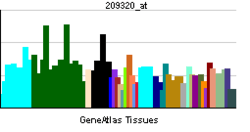ADCY3
Adenylate cyclase type 3 is an enzyme that in humans is encoded by the ADCY3 gene.[1][2]
Function
This gene encodes adenylyl cyclase 3, which is a membrane-associated enzyme and catalyzes the formation of the secondary messenger cyclic adenosine monophosphate (cAMP).[2]
The ADCY3 subtype likely mediates odorant detection (possibly) via modulation of intracellular cAMP concentration.[3]
References
- ↑ Yang B, He B, Abdel-Halim SM, Tibell A, Brendel MD, Bretzel RG et al. (Jan 1999). "Molecular cloning of a full-length cDNA for human type 3 adenylyl cyclase and its expression in human islets". Biochemical and Biophysical Research Communications 254 (3): 548–551. doi:10.1006/bbrc.1998.9983. PMID 9920776.
- ↑ 2.0 2.1 "Entrez Gene: ADCY3 adenylate cyclase 3".
- ↑ "Gene Cards: ADCY3 Gene". Retrieved 2012-12-30.
Further reading
- Gaudin C, Homcy CJ, Ishikawa Y (Nov 1994). "Mammalian adenylyl cyclase family members are randomly located on different chromosomes". Human Genetics 94 (5): 527–9. doi:10.1007/BF00211020. PMID 7959689.
- Haber N, Stengel D, Defer N, Roeckel N, Mattei MG, Hanoune J (Jul 1994). "Chromosomal mapping of human adenylyl cyclase genes type III, type V and type VI". Human Genetics 94 (1): 69–73. doi:10.1007/BF02272844. PMID 8034296.
- Hellevuo K, Yoshimura M, Kao M, Hoffman PL, Cooper DM, Tabakoff B (Apr 1993). "A novel adenylyl cyclase sequence cloned from the human erythroleukemia cell line". Biochemical and Biophysical Research Communications 192 (1): 311–318. doi:10.1006/bbrc.1993.1415. PMID 8476432.
- Wei J, Wayman G, Storm DR (Sep 1996). "Phosphorylation and inhibition of type III adenylyl cyclase by calmodulin-dependent protein kinase II in vivo". The Journal of Biological Chemistry 271 (39): 24231–24235. doi:10.1074/jbc.271.39.24231. PMID 8798667.
- Nagase T, Ishikawa K, Miyajima N, Tanaka A, Kotani H, Nomura N et al. (Feb 1998). "Prediction of the coding sequences of unidentified human genes. IX. The complete sequences of 100 new cDNA clones from brain which can code for large proteins in vitro". DNA Research 5 (1): 31–39. doi:10.1093/dnares/5.1.31. PMID 9628581.
- Wei J, Zhao AZ, Chan GC, Baker LP, Impey S, Beavo JA et al. (Sep 1998). "Phosphorylation and inhibition of olfactory adenylyl cyclase by CaM kinase II in Neurons: a mechanism for attenuation of olfactory signals". Neuron 21 (3): 495–504. doi:10.1016/S0896-6273(00)80561-9. PMID 9768837.
- Barcova M, Speth C, Kacani L, Uberall F, Stoiber H, Dierich MP (Mar 1999). "Involvement of adenylate cyclase and p70(S6)-kinase activation in IL-10 up-regulation in human monocytes by gp41 envelope protein of human immunodeficiency virus type 1". Pflügers Archiv 437 (4): 538–546. doi:10.1007/s004240050815. PMID 10089566.
- Speth C, Joebstl B, Barcova M, Dierich MP (Apr 2000). "HIV-1 envelope protein gp41 modulates expression of interleukin-10 and chemokine receptors on monocytes, astrocytes and neurones". Aids 14 (6): 629–636. doi:10.1097/00002030-200004140-00001. PMID 10807185.
- Patke CL, Shearer WT (May 2000). "gp120- and TNF-alpha-induced modulation of human B cell function: proliferation, cyclic AMP generation, Ig production, and B-cell receptor expression". The Journal of Allergy and Clinical Immunology 105 (5): 975–982. doi:10.1067/mai.2000.105315. PMID 10808179.
- Vanvooren V, Allgeier A, Cosson E, Van Sande J, Defer N, Pirlot M et al. (Dec 2000). "Expression of multiple adenylyl cyclase isoforms in human and dog thyroid". Molecular and Cellular Endocrinology 170 (1-2): 185–196. doi:10.1016/S0303-7207(00)00322-1. PMID 11162902.
- Patrizio M, Colucci M, Levi G (Apr 2001). "Human immunodeficiency virus type 1 Tat protein decreases cyclic AMP synthesis in rat microglia cultures". Journal of Neurochemistry 77 (2): 399–407. doi:10.1046/j.1471-4159.2001.00249.x. PMID 11299302.
- Côté M, Guillon G, Payet MD, Gallo-Payet N (Sep 2001). "Expression and regulation of adenylyl cyclase isoforms in the human adrenal gland". The Journal of Clinical Endocrinology and Metabolism 86 (9): 4495–4503. doi:10.1210/jc.86.9.4495. PMID 11549699.
- Speth C, Schabetsberger T, Mohsenipour I, Stöckl G, Würzner R, Stoiber H et al. (Apr 2002). "Mechanism of human immunodeficiency virus-induced complement expression in astrocytes and neurons". Journal of Virology 76 (7): 3179–3188. doi:10.1128/JVI.76.7.3179-3188.2002. PMC 136041. PMID 11884542.
- Kobayakawa K, Hayashi R, Morita K, Miyamichi K, Oka Y, Tsuboi A et al. (Jul 2002). "Stomatin-related olfactory protein, SRO, specifically expressed in the murine olfactory sensory neurons". The Journal of Neuroscience 22 (14): 5931–7. PMID 12122055.
- Ludwig MG, Seuwen K (2003). "Characterization of the human adenylyl cyclase gene family: cDNA, gene structure, and tissue distribution of the nine isoforms". Journal of Receptor and Signal Transduction Research 22 (1-4): 79–110. doi:10.1081/RRS-120014589. PMID 12503609.
- Katsel PL, Tagliente TM, Schwarz TE, Craddock-Royal BD, Patel ND, Maayani S (Feb 2003). "Molecular and biochemical evidence for the presence of type III adenylyl cyclase in human platelets". Platelets 14 (1): 21–33. doi:10.1080/0953710021000062905. PMID 12623444.
- Celano M, Arturi F, Presta I, Bruno R, Scarpelli D, Calvagno MG et al. (May 2003). "Expression of adenylyl cyclase types III and VI in human hyperfunctioning thyroid nodules". Molecular and Cellular Endocrinology 203 (1-2): 129–135. doi:10.1016/S0303-7207(03)00086-8. PMID 12782409.
| |||||||||||||||||||||||

